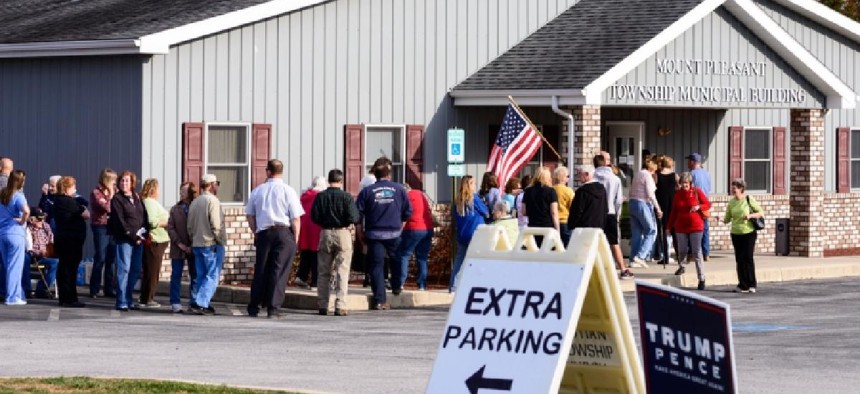Elections (Archived)
By the numbers: the Top 10 counties by GOP voter registration gains

Voters waiting in line to cast their ballots in the 2016 United States Presidential Election in Mount Pleasant Township, Adams County. Photo by Bill Dowling for Shutterstock
Pennsylvania Democrats have been through a lot recently, but if the party hopes to begin the process of turning the state blue again, more attention must be paid to some vitally important information on voter registration that might have gotten missed amid the circus in D.C.
In retrospect, the county changes in voter registration proved to be quite the reliable indicator of the presidential election results.
To make matters worse for the Democrats, after re-examining the numbers to see if they had stopped the bleeding, it quickly became apparent that the regular culling of long-term inactives has led to even more Republican gains.
Last October, the Democrats held a lead of 913,017 (4,157,140 Dems to 3,244,123 Republicans). The most recent count shows the GOP chipping that number down to 808,974 (4,030,393 to 3,221,419).
Broken down by county, Republicans have seen net improvement in all but three counties: Chester, Delaware and Montgomery.
The following is a list of the Top 10 counties in terms of net additional Republican voters.
10. Bucks - 2,860
This Southeastern PA county was once considered the ultimate bellwether of Pennsylvania. From 1972 to 2012, as went Bucks, so went the Keystone State and its electoral votes.
Yet last year, Bucks narrowly went for Hillary while Trump edged ahead statewide.
Bucks County Dems are facing a major crisis as their county heads in the opposite direction of the other SEPA battlegrounds. All told, their edge has dropped from 12,138 to 6,640 voters in the last 15 months.
9. Cambria - 3,089
The first of several Southwestern PA counties to appear on this list, Cambria is home to Johnstown, represented for decades by quintessential blue-collar Democrat Jack Murtha. Nowadays, though, the county has become emblematic of how Appalachia is probably the worst area in the nation for Dems.
For example, Barack Obama narrowly won Cambria in 2008, while eight years later Donald Trump captured two-thirds of the vote.
8. Beaver - 3,284
Another SWPA county that’s been bleeding registered Democrats, Beaver still has more Dems than Republicans, yet the GOP is starting to win local offices in addition to national and statewide victories.
The real fear for the blue team is that this steady surge of Republican growth in the county is nowhere near over.
7. Fayette - 3,318
From 1932 to 2004, Fayette County went blue in 18 out of 19 presidential elections. It’s been red ever since. Back in May of 2016, Dems had a 27,000+ voter advantage. Today that number stands at less than 18,000.
6. York - 3,439
For about nine months during the American Revolution, York was actually the nation’s capital as it housed the Second Continental Congress.
Since then, the county has been relatively ignored – until recently, as the prospect of two native sons battling for the Governor’s Mansion next year looms.
Unfortunately for Gov. Wolf, York County looks more like State Sen. Scott Wagner’s terrain as the GOP lead there has grown from 33,803 to 46,179 since the conclusion of the 2016 primaries.
5. Lackawanna - 3,821
On Election Night 2016 as Hillary Clinton’s lead slowly evaporated, Democrats wondered in shocked tones how Donald Trump's massive upset could have happened. It was NBC’s Steve Kornacki who first pointed out that Lackawanna County may have been the culprit.
Scranton had always delivered solid returns for Dems, with Barack Obama and native son Joe Biden pulling in 62.2% and 62.9% respectively in their two runs. Nonetheless, in 2016, Clinton garnered just 49.8%.
Lackawanna is still the fourth-best county for Democrats in the state, but if it starts going the way of the west, their chances of ever winning PA again may vanish.
4. Westmoreland - 3,886
Westmoreland was once a core component of the Democratic coalition in Southwest Pennsylvania. Yet at its current pace, it’ll be a Republican county soon.
In only fifteen months, their voter advantage of 26,753 has shrunk to just 7,285.
3. Northampton - 3,894
“For every blue-collar Democrat we lose in western Pennsylvania,” Sen. Chuck Schumer told the National Review last year “we will pick up two moderate Republicans in the suburbs in Philadelphia.”
Of course, this didn’t happen. An under-appreciated aspect of the presidential results is that although Clinton suffered from losses among blue-collar whites, she still could have been saved by white-collar suburbanites in the Lehigh Valley and SEPA. Efforts in the Southeast were partially successful, but the Lehigh Valley was ultimately cruel to the Democratic candidate.
Since 1952, whoever won Northampton County also took the state’s electoral votes. That streak continued when Trump pulled off both upsets.
2. Berks - 3,974
Another Lehigh Valley county the Democrats desperately need if they are going to reverse their electoral fortunes, the home of Reading actually went for Obama in 2008 and the 44th President very nearly won it again four years later. The Dems will likely need to take it in 2020 if they hope to take back the White House.
1. Philadelphia - 31,728
That Philly “won” this list is at once surprising and completely understandable. After all, it’s far and away the most populous part of the commonwealth.
Dems have increasingly depended on huge margins out of the city to prop up their statewide candidates. So while these GOP gains may seem insignificant in comparison to Philadelphia’s total population, the shift strikes at the heart of the Democratic Party.
It’s vital for Democrats to compete everywhere but you still require a strong homebase in order to succeed.
